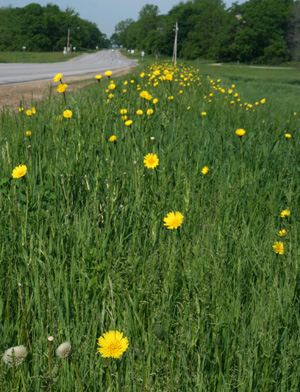
Yellow goatsbeard is a common name used for two similar weedy plants from Eurasia in the daisy family (Asteraceae), apparently introduced as garden plants in the early 1900s. Both are naturalized across much of North America, including Wisconsin, primarily in disturbed sites such as weedy meadows, pastures, abandoned agricultural fields, vacant lots and along railroads. They are particularly noticeable along roadsides. Although they prefer full sun, these species are somewhat shade tolerant and can occur in woodlands and forests.
Tragopogon pratensis is more common in southern parts of the state and is frequently seen in grassy areas along roadside ditches.

Some other common names for this species include lesser goat’s-beard, meadow salsify, showy goat’s-beard, and yellow salsify. The very similar Tragopogon dubius is also common throughout Wisconsin, but is found in drier areas than T. pratensis, often in open, gravelly areas. Some common names for this species include fistulous goat’s-beard, greater sand goat’s-beard, sand goatsbeard, western goatsbeard, western salsify, and yellow salsify. The closely related oyster plant, Tragopogon porrifolius, is grown as a vegetable for its edible roots, having escaped and naturalized in only a few places in Wisconsin, primarily in the southeast part of the state. It is readily differentiated from the other species by its purple flowers. These three species will interbreed, creating hybrid species.

These erect plants are typically biennials, although sometimes grow as annuals or monocarpic perennials remaining vegetative for up to 10 years before flowering (blooming only when root crown diameter

reaches a minimum size). In the first year they are low-growing rosettes growing from the fleshy taproot. Normally in the second year the rosettes die back and flowering stems 1-3 feet tall are produced. Plants growing in richer, moister soils grow taller than those in poor, dry soils. After flowering, the plant dies. They reproduce only by seed.
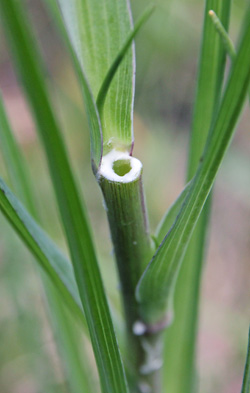
The foliage is a medium blue-green, although T. dubius tends to be a paler green. The plants have alternate, lanceolate-linear leaves with smooth edges and pointed tips. The leaves become smaller up the rounded stem. The stem is often enlarged where each strongly clasping leaf attaches. The two species are readily distinguished by their leaves: T. dubius has straight leaves while the ends of the leaves of T. pratensis are curved backwards. In both species the sap from the roots, stems, and leaves is a milky latex. These plants are often mistaken for a grass, especially before flowering.
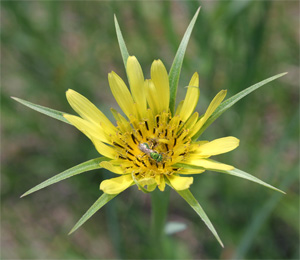
These plants begin blooming in late spring through mid- summer, opening in the morning and closing by afternoon. Many species of bees and flies visit the flowers for nectar or pollen. The daisy-like flowers of these two species are similar, especially when viewed from a distance. Each inflorescence is a single terminal head on a long, hairless stalk. The flowerheads are ¾-2½ inches across with numerous yellow ray florets; the outer florets are noticeably longer than the inner florets. The outer end of each floret is squared off with 5 small teeth (or sometimes rounded in T. dubius). The center of the inflorescence has numerous black anthers. The species can be distinguished by the color and length of the green floral bracts. T. pratensis has bright yellow petals and about 8 floral bracts that extend only to or slightly beyond the flowerhead,
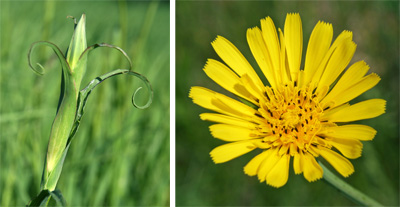
while the petals of T. dubius are a paler yellow and it has many floral bracts that extend well beyond the margins of the flowerhead.
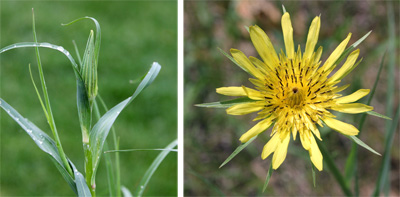
The flowers are followed by seedheads resembling a dandelion on steroids.
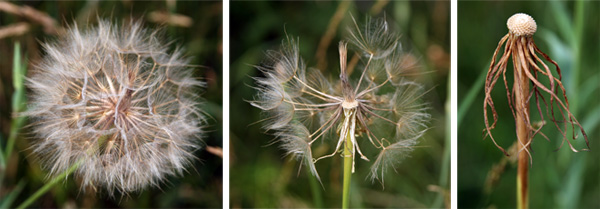
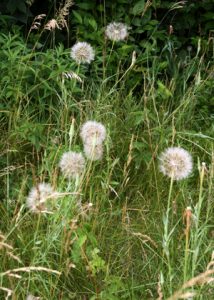
Each floret that was pollinated produces an elongated brown seed tapering into a stout beak (an achene that is 1-1½ inches long) and a fluffy white to light brown pappus. This tuft of hairs has a plume-like appearance as the hairs have small feather-like bristles. Together these form a large ball about 3 inches across.
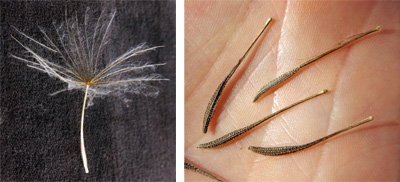
The seeds break easily from the flower when ripe. The seeds are dispersed by the wind, floating short distances (typically within 15 feet of the parent plant) with the aid of the pappus. Seed viability is only a year or two. Seed germination is best in full light and moderate temperatures. The seedlings resemble a young grass plant.

Although Tragopogon species may be persistent in open grassland or shrublands, they are much more common in disturbed sites, and are rarely abundant in any vegetation type and do not occupy much cover. They are not considered aggressive and do not seem to have any significant impacts on native vegetation. Both species can be controlled by cultivation, pulling or with herbicides.
– Susan Mahr, University of Wisconsin – Madison
Latest Horticulture News
Ask Your Gardening Question
If you’re unable to find the information you need, please submit your gardening question here:





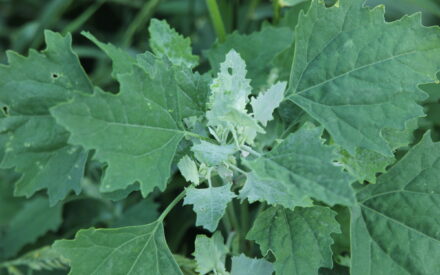 Common Weed Seedlings of the North Central States
Common Weed Seedlings of the North Central States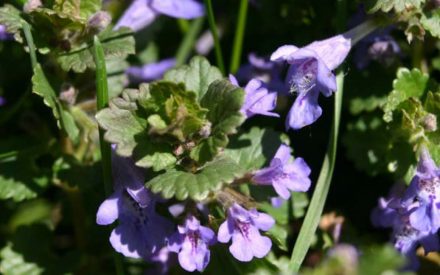 Creeping Charlie
Creeping Charlie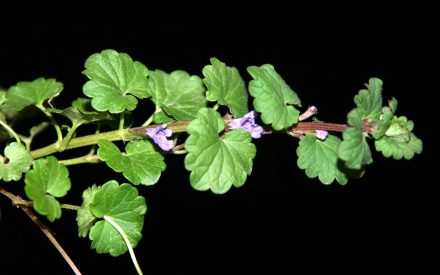 Controlling Creeping Charlie, Gleochoma hederaceae
Controlling Creeping Charlie, Gleochoma hederaceae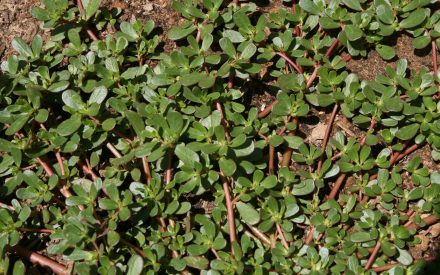 Common Purslane, Portulaca oleracea
Common Purslane, Portulaca oleracea


